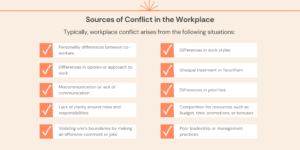HR rockstars and line managers, let’s face it: workplace conflict is inevitable, but it doesn’t have to suck the life out of your organization. In fact, it can be beneficial if dealt with correctly. Conflict allows teams to come to terms with difficult situations, synthesize diverse perspectives, and make sure solutions are well thought-out. Also, it can shine a light on deeper problems that need to be addressed, leading to the earlier identification of problems.
Workplace conflict becomes problematic when you try to sweep it under the rug and avoid resolving it early on. Positive conflict management can save time and energy in the long run, as it can require a lot of effort to turn a negative conflict into a positive one. Plus, you’ll be able to enjoy the sweet, sweet sounds of silence in your inbox for once!
In this post, we’ll cover everything you need to know about workplace conflict, why resolving it is important, and most importantly, how to resolve it with style. We’ll also talk about how to prevent conflict from happening in the first place because, let’s be real, prevention is better than cure.
So, let’s get to it, shall we?
What is workplace conflict?
Workplace conflict refers to any disagreement or dispute between two or more employees in a work environment. It’s a natural part of the workplace, but if not handled correctly, it can have negative effects on your employees’ morale and productivity. It’s important to remember that conflict resolution isn’t just about resolving the issue at hand; it’s about ensuring that everyone feels safe at work so they can continue working together effectively.

How to Recognize Signs Of Conflict
It’s important to be able to recognize the signs of conflict before it escalates into a full-blown reality TV drama series. Some common signs of conflict in the workplace include:
Tension or hostility between individuals or groups
Gossip or rumors
Lack of cooperation or teamwork
Poor morale or engagement
Increased absenteeism or turnover
Decreased productivity or efficiency
Increased stress or burnout
Complaints or grievances
If you notice any of these signs, you need to take immediate action to address the issue.
Strategies for Resolving Conflict and Building a Happier Workplace
Now, let’s get down to the nitty-gritty. There are several strategies that HR professionals and line managers can use to resolve conflict and build a happier, more productive work environment. Here are some proven strategies to consider:
Address conflicts early: Provide a safe and confidential space for employees to voice their concerns. Establishing psychological safety is an essential prerequisite for enabling employees to share their thoughts and speak up without fear of retribution.
Team Building Strategies: Create stronger teams by building trust and respect amongst colleagues. Developing closeness and being part of a cohesive group have several benefits. While indifferent and weak connections within teams may cause stress and dissatisfaction, strong in-group bonds improve morale, increase motivation, and promote trusting, respectful engagement between team members.
Use active listening: Use active listening skills to ensure that all parties feel heard and understood. This can include paraphrasing, summarizing, and asking clarifying questions to make sure you’re on the same page.
Find common ground: Help employees find common ground and identify shared goals and interests. This can help to build relationships and promote cooperation and teamwork.
Use a mediator: In extreme cases consider using a neutral third party, such as a mediator, to help resolve conflicts. A mediator can help to facilitate communication, promote understanding, and find a mutually acceptable solution.
Provide training and resources: Give employees the tools they need to manage conflicts and stress effectively. Provide conflict resolution training and other resources.
Address underlying issues: Don’t just treat the symptoms, address the root cause of the conflict, whether it’s poor leadership, discrimination, or a toxic work environment.
Lead by example: Line managers should model the behavior they want to see in others. Leaders should encourage open communication, collaboration, and mutual trust among team members. Remind your leaders to be aware of their personal biases when dealing with conflict resolution, and try to keep an open mind.
Foster a culture of respect: Encourage employees to treat each other with dignity and as equals regardless of their position or rank within the organization. For example, try to include the following sentence in your team meetings: “I would like you all on my team to feel comfortable speaking up when there’s something on your mind–even if it means disagreeing with me”.
The Role of HR Professionals
As a human resources professional, you play an important role in helping to resolve conflicts and build a happier workplace.
- The first step is to educate yourself on how to mediate and resolve conflict in the workplace to build strong teams grounded on trust, respect, and shared identity. To learn more and get started today, download our step-by-step team-building toolkit. The toolkit is equipped with ready-made exercises, line manager templates and guides, and more. Get instant access here.
- Then you should develop policies and a code of conduct to build a collaborative culture and make it super clear that no form of abuse or harassment will be tolerated.
- Lastly, provide training for all employees so they know what the expectations are for resolving conflicts in the workplace. Practical exercises and workshop guides can be found on our Team-Building Exercises Toolkit.
Remember, conflict is not going anywhere, but you can control the outcome. Use the strategies we’ve discussed today, and you’ll be on your way to resolving conflicts and building a happier, healthier, and more engaging workplace for your employees.
Got questions or need support with creating a healthier workplace? Then I would love to hear from you! E-Mail me directly at stavy@workunlocked.com or book a free 30-minute call with me!
Have a great day at work!




